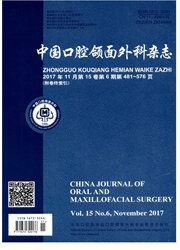

 中文摘要:
中文摘要:
目的 :设计并制作数字化导板(digital template),指导标准型人工颞下颌关节置换术中的骨修整和假体定位并评价其应用效果。方法:选择2013年11月—2014年3月间收治的人工关节置换病例6例,术前将Biomet标准型人工关节假体激光扫描后导入Pro Plan CMF 1.4软件,模拟假体摆放位置并据此确定骨修整范围,设计、制作多块数字化导板,分别用于术中指示骨修整范围、方向及深度,并定位假体安放位置。术后进行CT扫描,评价假体植入准确性及其与术前设计的吻合情况。结果:导板术中就位顺利,与骨面贴合,引导截骨及骨修整准确,未伤及颅底及下牙槽神经血管束等重要解剖结构。术后CT拟合结果显示,假体植入位置与术前设计的平均误差为(1.139±0.183)mm。结论:数字化导板可以准确指导标准型人工颞下颌关节置换术中的骨修整和假体定位,有利于确保假体植入的稳定性,避免了颅底及下牙槽神经血管束的损伤。
 英文摘要:
英文摘要:
PURPOSE: To investigate the application of digital template in total temporomandibular joint(TMJ)replacement. METHODS: Six patients who needed total temporomandibular joint replacement surgery from Nov. 2013 to Mar. 2014 were included in this study. Preoperative design was performed using the Pro Plan CMF 1.4 software. The total TMJ replacement prostheses of Biomet system were scanned and imported into the software, and were simulated to be placed at the appropriate position. Then the osteotomy line and trimming scope were determined, and digital templates for assisting bone trimming and prosthesis implantation were designed accordingly. Rapid prototyping(RP) technique was used to make the templates. Intraoperative application effect and merging result of postoperative and preoperative CT were evaluated and analyzed. RESULTS: Intraoperative navigation worked accurately. Important anatomical structures such as the skull base and inferior alveolar neurovascular bundle were not injured during surgery. The result of postoperative CT merged with preoperative CT showed the prostheses position matched with the preoperative design well with an error of(1.139 ±0.183) mm. CONCLUSIONS: Digital template can be regarded as an effective assist for total TMJ replacement surgery of Biomet system.
 同期刊论文项目
同期刊论文项目
 同项目期刊论文
同项目期刊论文
 Complete resection and immediate reconstruction with costochondral graft for recurrent aneurysmal bo
Complete resection and immediate reconstruction with costochondral graft for recurrent aneurysmal bo 期刊信息
期刊信息
